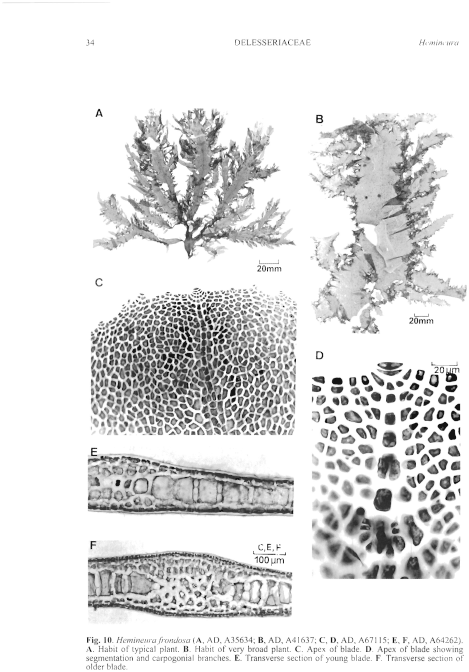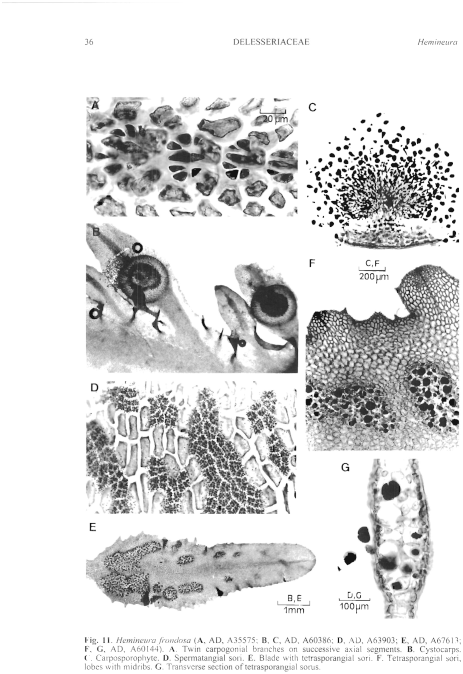|
|
|
|
|
|||||||||||
|
Electronic Flora of South Australia Species Fact Sheet
Phylum Rhodophyta – Family Delesseriaceae
Selected citations: De Toni 1900: 719. Fuhrer et al. 1981: pl. 32. Guiler 1952: 101. Huisman 1997: 201; 2000: 148. Huisman & Walker 1990: 429. Kylin 1924: 6, fig. 1; 1956: 434. Lin et al. 1997: 64; 2001: 135, figs 1–37. Lucas 1909: 37; 1929a: 20; 1929b: 50. Lucas & Perrin 1947: 232, fig. 95. May 1965: 400. Schmitz & Hauptfleisch 1897: 412. Shepherd & Womersley 1970: 135; 1981: 366. Silva et al. 1996: 456. Sonder 1853: 691. Womersley 1950: 183. Wynne 1985a: 77; 1996: 179.
Synonyms
Delesseria (Hemineura) frondosa Hooker & Harvey 1847: 403. J. Agardh 1852: 689; 1876: 485; 1879: 187, pl. 26 figs 18, 19; 1898: 180. Harvey 1859b: 312; 1860: pl. 179; 1863, synop.: xxxi. Reinbold 1897: 14. Sonder 1880: 24. Tate 1882a: 20. Tisdall 1898: 509. Wilson 1892: 174.
Hypoglossum frondosum (Hooker & Harvey) Kützing 1849: 876.
Hemineura crispata Harvey 1855a: 549. Silva et al. 1996: 456.
Hemineura wilsonis J. Agardh 1898: 180. De Toni 1900: 720. Guiler 1952: 101. Kylin 1924: 6. Lucas 1909: 37; 1929a: 20. May 1965: 400.
Thallus (Fig. 10A, B) medium red to red-brown, 5–40 cm high, complanate, usually irregularly branched with elongate axes and main branches 0.5–2 cm broad bearing marginal proliferations, sometimes foliose and 4–10 cm broad with crispate margins; marginal proliferations elongate-ovate to lanceolate, 5–10 (–20) mm long and usually 2–4 mm broad. Midrib present in all blades, not extending to that in the parent blade, becoming corticated; wings 120–250 µm thick, present to near base of the thallus, lost from a short stipe. Holdfast discoid to lacerate and fibrous, 1–5 (–20) mm across; epilithic or occasionally epiphytic or epizoic. Structure. Apical cells (Fig. 10D) broadly obconical, segmenting to axial cells each with 2 lateral pericentral cells and later 2 transverse ones, the lateral pericentral cells forming second-order rows with only occasional cells forming third-order cells or short rows; transverse intercalary divisions occur in second- and third-order rows, with only the second-order rows and outermost third-order cells reaching the blade margin; the surface cell arrangement of the blade becomes irregular (Fig. 10C). The blade margin has some cells projecting as slight dentations and dividing (Fig. 10C), some of which recommence growth to form new marginal exogenous blades with apical cells dividing as in the main blades, but without the new midrib connecting back to that in the parent blade (Fig. 11F). Cortication occurs first over the midrib from the transverse pericentral cells, and the cells of the wings cut off a layer of smaller cortical cells on both sides; in older parts the cortex becomes 2 cells thick and 3–4 cells thick over the midrib; transverse sections (Fig. 10E, F) show a regular arrangement of a central layer of large, shortly obloid cells 60–120 (–150) µm across and cortical layers of small, dimidiate, cells 20–35 µm across. Mature cells multinucleate; rhodoplasts discoid, chained in larger cells.
Reproduction: Gametophytes dioecious. Procarps (Fig. 11A) developed in series from transverse pericentral cells on both sides of the blades, with each supporting cell forming 2 sterile cells (groups) and two 4-celled carpogonial branches. Carposporophytes (Fig. 11C) with an elaborate, branched, fusion cell, much branched gonimoblast and short terminal rows of clavate to ovoid carposporangia 35–50 µm in diameter, maturing sequentially. Cystocarps (Fig. 11B) situated on the midrib, single, hemispherical, 0.8–2 mm across, ostiolate, with a beaked pericarp 4–8 cells thick. Spermatangia in small to extensive sori (Fig. 11D) on both sides of the wings, forming rounded to elongate-oblong patches, with spermatangia cut off from cortical initials.
Tetrasporangial sori (Fig. 11E, F) scattered, becoming extensive between the midrib and margins, 250–300 µm thick, with tetrasporangia in 2 irregular layers (Fig. 11G) of mixed ages, cut off mainly from inner cortical cells, with an overlying cortex of small cells; tetrasporangia subspherical, 40–90 µm in diameter.
Type from Tasmania (Gunn); lectotype in BM.
Selected specimens: White I., Houtman Abrolhos, W. Aust., 7–19 m deep (Kraft, Saunders & Strachan, 10.xi.1995; MELU, K10798; AD, A67978). Point Peron, W. Aust., drift (Parsons, 15.xi.1968; AD, A34292). Elliston, S. Aust., 7 m deep (Shepherd, 21.x.1970; AD, A37570). Price I., Point Avoid, S. Aust., 21 m deep (Branden, 6.i.1989; AD, A59973). Toad Head, West I., S. Aust., 22–26 m deep (Shepherd, 15.i.1966; AD, A30145). Middleton, S. Aust., drift (Womersley, 14.xi.1965; AD, A29690). Vivonne Bay, Kangaroo I., S. Aust., drift (Womersley, 24.i.1946; AD, A3313). Robe, S. Aust., drift (Womersley, 15.iv.1994; AD, A63547). Stinky Bay, Nora Creina, S. Aust., drift (Womersley, 26.x.1996; AD, A67115). Blackfellows Caves, SE S. Aust., drift (Hotchkiss, 3.xi.1997; AD, A67613). Cape Northumberland, S. Aust., shaded lower eulittoral depressions (Womersley & Ricci, 1.xi.1993; AD, A63257). "The Fort", S Channel, Port Phillip, Vic., 12 m deep (Battershill, 9.ii.1990; AD, A60144). Crawfish Rock, Westernport Bay, Vic., 5–10 m deep (Watson, 10.xi.1968; AD, A33056). Walkerville, Vic., drift (Sinkora A2115, 28.ii.1975; AD, A48416). Gabo I., Vic., 26 m deep (Millar & O'Brien, 4.xii.1996; NSW, 438978). Low Head, Tas. (Perrin, 8.x.1950; AD, A49593). Sarah I., Bathurst Ch., SW Tas., 2–5 m deep (Edgar, 11.iii.1995; AD, A64262). Two Mile Creek, St Patricks Head, E Tas., 6 m deep (AIMS-NCI, Q66C 3717-H, 26.ii.1990; AD, A60386). Marion Bay, Tas., 6 m deep (Shepherd, 13.ii.1970; AD, A35634). Surveyors Cove, Port Arthur, Tas., 13–19 m deep (McGeary-Brown, 29.x.1986; AD, A57421). Arch Rock, Ninepin Point, Tas., 5–12 m deep (Sanderson, 21.x.1994; AD, A63879). Taroona, Tas., 0–10 m deep (Shepherd, 4.ii.1970; AD, A35575). Fluted Cape, Bruny I., Tas., 7–10 m deep (Shepherd, 10.ii.1972; AD, A41461) and 1–10 m deep (Andrews, 21.x.1994; AD, A63903). Satellite I., D'Entrecasteaux Ch., Tas., 12 m deep (Shepherd, 17.ii.1972; AD, A41637).
Distribution: Houtman Abrolhos, W. Aust., to Gabo I., Vic., and around Tasmania.
Taxonomic notes: Hemineura frondosa is highly variable in habit, especially in width of the main frond and laterals, and coarseness of the midrib.
Hemineura crispata Harvey (lectotype from Rottnest I., W. Aust., in Trav. Set 312, Herb, Harvey, TCD) is based on small and young specimens of H. frondosa, whereas H. wilsonis J. Agardh (lectotype in Herb. Agardh, LD, 31427) from Port Phillip Heads, Vic., is based on older specimens of H. frondosa.
References:
AGARDH, J.G. (1852). Species Genera et Ordines Algarum. Vol. 2, Part 2, pp. 337–720. (Gleerup: Lund.)
AGARDH, J.G. (1876). Species Genera et Ordines Algarum. Vol. 3, Part 1 - Epicrisis systematis Floridearum, pp. i-vii, 1–724. (Weigel: Leipzig.)
AGARDH, J.G. (1879). Florideernes morphologi. K. Svenska Vetensk. Akad. Handl. 15(6), 1–199, Plates 1–33.
AGARDH, J.G. (1898). Species Genera et Ordines Algarum. Vol. 3, Part 3 - De dispositione Delesseriearum. (Gleerup: Lund.)
DE TONI, G.B. (1900). Sylloge Algarum omnium hucusque Cognitarum. Vol. 4. Florideae. Sect. 2. pp. 387–776. (Padua.)
FUHRER, B., CHRISTIANSON, I.G., CLAYTON, M.N. & ALLENDER, B.M. (1981). Seaweeds of Australia. (Reed: Sydney.)
GUILER, E.R. (1952). The marine algae of Tasmania. Checklist with localities. Pap. Proc. R. Soc. Tasmania 86, 71–106.
HARVEY, W.H. (1849a). Nereis Australis, pp. 65–124, Plates 26–50. (Reeve: London.)
HARVEY, W.H. (1855a). Some account of the marine botany of the colony of Western Australia. Trans. R. Jr. Acad. 22, 525–566.
HARVEY, W.H. (1859b). Algae. In Hooker, J.D., The Botany of the Antarctic Voyage. III. Flora Tasmaniae. Vol. II, pp. 282–343, Plates 185–196. (Reeve: London.)
HARVEY, W.H. (1860). Phycologia Australica. Vol. 3, Plates 121–180. (Reeve: London.)
HARVEY, W.H. (1863). Phycologia Australica. Vol. 5, Plates 241–300, synop., pp. i-lxxiii. (Reeve: London.)
HOOKER, J.D. & HARVEY, W.H. (1847). Algae Tasmanicae. Lond. J. Bot. 6, 397–417.
HUISMAN, J.M. & WALKER, D.I. (1990). A catalogue of the marine plants of Rottnest Island, Western Australia, with notes on their distribution and biogeography. Kingia 1, 349–459.
HUISMAN, J.M. (1997). Marine Benthic Algae of the Houtman Abrolhos Islands, Western Australia. In Wells, F.E. (Ed.) The Marine Flora and Fauna of the Houtman Abrolhos Islands, Western Australia, pp. 177–237. (W. Aust. Museum: Perth.)
HUISMAN, J.M. (2000). Marine Plants of Australia. (Univ. W. Aust. Press, Nedlands, W. Aust. & ABRS, Canberra, A.C.T.)
KÜTZING, F.T. (1849). Species Algarum. (Leipzig.)
KYLIN, H. (1924). Studien über die Delesseriaceen. Lunds Univ. Årsskr. N.F. Avd. 2, 20(6), 1–111.
KYLIN, H. (1956). Die Gattungen der Rhodophyceen. (Gleerups: Lund.)
LIN, S.M., HOMMERSAND, M.H. & KRAFT, G.T. (1997). Characterization of Hemineura frondosa, Hemineurieae trib. nov. (Delesseriaceae, Rhodophyta) from southern Australia. Phycologia 36(4) suppl. p. 64.
LIN, S.-M., FREDERICQ, S. & HOMMERSAND, M.H. (2001). Systematics of the Delesseriaceae (Ceramiales, Rhodophyta) based on large subunit rDNA and rbc L sequences, including the Phycodryoideae, subfam. nov. J. Phycol. 37, 881–899.
LUCAS, A.H.S. & PERRIN, F. (1947). The Seaweeds of South Australia. Part 2. The Red Seaweeds. (Govt Printer: Adelaide.)
LUCAS, A.H.S. (1909). Revised list of the Fucoideae and Florideae of Australia. Proc. Linn. Soc. N.S.W. 34, 9–60.
LUCAS, A.H.S. (1929a). The marine algae of Tasmania. Pap. Proc. R. Soc. Tasm. 1928, 6–27.
LUCAS, A.H.S. (1929b). A census of the marine algae of South Australia. Trans. R. Soc. S. Aust. 53, 45–53.
MAY, V. (1965). A census and key to the species of Rhodophyceae (red algae) recorded from Australia. Contr. N.S. W. Natl Herb. 3, 349–429.
REINBOLD, T. (1897). Die Algen der Lacepede und Guichen Bay und deren náherer Umgebung (Slid Australien), gesammelt von Dr. A. Engelhart-Kingston. Nuova Notarisia 8, 41–62.
SCHMITZ, F. & HAUPTFLEISCH, P. (1897). Delesseriaceae. In Engler, A. & Prantl K., Die natürlichen Pflanzenfamilien. T. 1. Abt. 2. Pp. 406–416.
SHEPHERD, S.A. & WOMERSLEY, H.B.S. (1970). The sublittoral ecology of West Island, South Australia: 1. Environmental features and algal ecology. Trans. R. Soc. S. Aust. 94, 105–137, Plate 1.
SHEPHERD, S.A. & WOMERSLEY, H.B.S. (1981). The algal and seagrass ecology of Waterloo Bay, South Australia. Aquat. Bot. 11, 305–371.
SILVA, P.C., BASSON, P.W. & MOE, R.L. (1996). Catalogue of the Benthic Marine Algae of the Indian Ocean. (Univ. California Press: Berkeley.)
SONDER, O.W. (1853). Plantae Muellerianae. Algae. Linnaea 25, 657–709.
SONDER, O.W. (1880). In Mueller, F., Fragmenta Phytographiae Australiae. Supplementum ad volumen undecinum: Algae Australianae hactenus cognitae, pp. 1–42, 105–107. (Melbourne.)
TATE, R. (1882a). A list of the charas, mosses, liverworts, lichens, fungs, and algals of extratropical South Australia. Trans. R. Soc. S. Aust. 4, 5–24.
TISDALL, H.T. (1898). The algae of Victoria. Rep. 7th Meet. Aust. Ass. Adv. Sci., Sydney, 1898, pp. 493–516.
WILSON, J.B. (1892). Catalogue of algae collected at or near Port Phillip Heads and Western Port. Proc. R. Soc. Viet. 4, 157–190.
WOMERSLEY, H.B.S. (1950). The marine algae of Kangaroo Island. III. List of Species 1. Trans. R. Soc. S. Aust. 73, 137–197.
WYNNE, M.J. (1985a). Taxonomic delineation of Phycodrina (Delesseriaceae, Rhodophyta), a new genus endemic to the Galapagos. Syst. Bot. 10, 73–80.
WYNNE, M.J. (1996). A revised key to genera of the red algal family Delesseriaceae. Nova Hedwigia 112, 171–190.
The Marine Benthic Flora of Southern Australia Part IIID complete list of references.
Publication:
Womersley, H.B.S. (24 February, 2003)
The Marine Benthic Flora of Southern Australia
Rhodophyta. Part IIID. Ceramiales – Delesseriaceae, Sarcomeniaceae, Rhodomelaceae
Reproduced with permission from The Marine Benthic Flora of Southern Australia Part IIID 2003, by H.B.S. Womersley. Australian Biological Resources Study, Canberra. Copyright Commonwealth of Australia.
Illustrations in Womersley Part IIIA, 2003: FIGS 10, 11.

Figure 10 enlarge
Fig. 10. Hemineura frondosa (A, AD, A35634; B, AD, A41637; C, D, AD, A67115; E, F, AD, A64262). A. Habit of typical plant. B. Habit of very broad plant. C. Apex of blade. D. Apex of blade showing segmentation and carpogonial branches. E. Transverse section of young blade. F. Transverse section of older blade.

Figure 11 enlarge
Fig. 11. Hemineura frondosa (A, AD, A35575; B, C, AD, A60386; D, AD, A63903; E, AD, A67613; F, G, AD, A60144). A. Twin carpogonial branches on successive axial segments. B. Cystocarps. C. Carposporophyte. D. Spermatangial sori. E. Blade with tetrasporangial sori. F. Tetrasporangial sori, lobes with midribs. G. Transverse section of tetrasporangial sorus.

|
Email Contact: State Herbarium of South Australia |

|